If an object is rotating about a fixed z-axis with constant angular
acceleration α, we have Δω = αΔt,
ωf = ωi + α(tf - ti).
The angular displacement θ about the z-axis is then given by
θf = θi + ωi(tf
- ti) + ½α(tf - ti)2.
These equations are of the same form as the equations for linear motion with constant acceleration a.
For
motion along the x-axis we have
vf = vi + a(tf - ti),
xf - xi = vxi∆t + ½ax(tf -
ti)2.
If we replace x by θ and a by α, then the kinematic
equations for linear motion along the x-axis transform into the
kinematic equations for rotational motion about the z-axis.
With our definitions of angular position, velocity, and acceleration, we have
kinematic equations for rotational motions that have the same form as the
kinematic equations for translational motion. And the same equations have
the same solutions. We solve them in exactly the same way. But the
solutions describe different physical situations. For example, while θf
can take on any value, a value that does not lie between 0 and 2π radians just
tells us that the object has completed more than one revolution.
Problem:
An airliner arrives at the terminal and the engines are shut
off. The rotor of one of the engines has an initial clockwise
angular speed of 2000 rad/s. The engines rotation slows with
an angular acceleration of magnitude 80 rad/s2.
(a) Determine the angular speed after 10 s.
(b) How long does it take the rotor to come to rest?
Solution:
- Reasoning:
In this problem the initial angular velocity ωi and the
angular acceleration α are given. If
we choose the direction of the initial angular acceleration
to be the z-direction, then
ωf = ωi - α(tf - ti),
since α is in the negative z-direction.
- Details of the calculations
(a) At t = 0, ωi
= 2000/s.
At t = 10 s we have ωf = 2000/s - (80/s2)(10
s) = 1200/s.
(b) Setting ωf = ωi - α(tf
- ti) = 0 we can find the time it takes the rotor to come
to rest.
2000/s - (80/s2)t = 0, t =
(2000/80)s = 25s is the time it takes the rotor to come to rest.
Problem:
A rotating wheel requires 3 s to rotate 37 revolutions. Its angular
velocity at the end of the 3 s interval is 98 rad/s. What is the
constant angular acceleration of the wheel?
Solution:
- Reasoning:
Given: Δθ = θf - θi = 37
revolutions, Δt = 3 s, ωf = 98 rad/s.
Using
θf - θi = ωi(tf - ti)
+ ½α(tf - ti)2 and ωf
= ωi +
α(tf - ti), we have two equations, which we can solve
for the two unknowns, ωi and α.
- Details of the calculation:
Using
θf = θi + ωi(tf - ti)
+ ½α(tf - ti)2 with θi
= 0, we have 37*2π = ωi*(3 s)
+ ½α(3 s)2.
Using ωf = ωi +
α(tf - ti) we have 98/s = ωi + α(3 s).
We solve this equation for ωi ωi
= 98 s - α(3 s), and insert
it into the first equation.
37*2π = (98/s)(3 s) - α(3 s)2 + ½α(3 s)2,
74π = 294 - α*(9 s2) + α*(4.5 s2),
(4.5 s2)*α = 294 - 74π, α = 13.67/s2 is the constant
acceleration of the wheel.
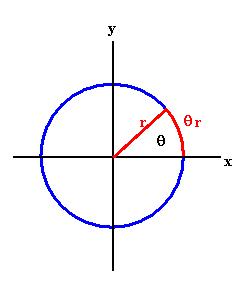 When a wheel rotates about the z-axis, each point on the wheel has the same angular
speed. The linear speed v of a point P, however, depends on its distance
from the axis of rotation.
When a wheel rotates about the z-axis, each point on the wheel has the same angular
speed. The linear speed v of a point P, however, depends on its distance
from the axis of rotation.
When a point P goes through an angular displacement of 2π, then
its distance traveled is 2πr.
When a point P goes through an angular displacement of π, then
its distance traveled is πr.
When a point P goes through an angular displacement of θ, then
its distance traveled is θr.
In terms of the angular speed ω, the speed v of the point P
therefore is v = ωr, if r is constant; v is the tangential velocity of the point P.
External link:
Tangential and angular speed (Youtube)
The tangential acceleration a of a point P moving along a circular path is given in
terms of its angular acceleration by at = rα.
The radial or centripetal acceleration is ar = v2/r =
rω2.
The total acceleration is given by
a = (at2 + ar2)½ =
(r2α2 + r2ω4)½ = r(α2 + ω4)½.
Problem:
If a car's wheels are replaced with wheels of a larger diameter, will the
reading of the speedometer change? Explain!
Solution:
- Reasoning:
The sensor for the speedometer senses the angular speed of the wheel.
Using vnominal = rnominalω, the speedometer displays
the correct speed if the tires have the nominal radius. If you put
larger tires on your car, then your actual speed vactual = ractualω
is greater than the displayed speed vnominal = rnominalω.
Problem:
A car accelerates uniformly from rest and reaches a speed of 22 m/s in
9 s If the diameter of a tire is 58 cm, find
(a) the number of revolutions the tire makes during this motion, assuming no
slipping, and
(b) the final rotational speed of the tire in revolutions per second.
Solution:
- Reasoning:
The uniform acceleration of the car a = Δv/Δt is given. We can use the
kinematic equations for linear motion to find the distance it travels in the
time interval Δt.
Dividing this distance by the circumference of the tire, we find the number
of revolution made. The final angular speed is given by ωf
= vf/rtire.
- Details of the calculation:
(a) The acceleration of the car is a =
Δv/Δt = (22 m/s)/(9 s) = 2.44 m/s2.
The distance
traveled in 9 s is d = ½at2 = (½*2.44*81) m = 99 m.
The circumference of the tire is π*0.58 m = 1.82 m.
The number of revolution made by the wheel is 99/1.82 = 54.3.
(b) The final linear speed of the tire is v = 22 m/s. Using v = ωr, ω = v/r the final angular speed is ω = 75.9/s.
The number of revolutions per second is ω/2π = 12/s.
Embedde Question 1
The kinematic equations for motion with constant linear acceleration and
motion with constant angular acceleration have the same form. Compare
motion with constant velocity with motion with constant angular velocity.
Discuss this with your fellow students in the discussion forum!
What causes angular acceleration?
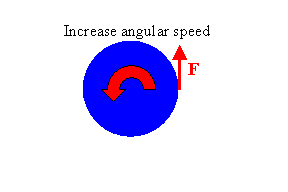 Assume you want to change a rotating
wheel's angular speed. To increase the angular speed you
probably will apply a force to the rim, tangential to the rim, and in
the direction of the instantaneous velocity of the section of the rim to
which you apply the force.
Assume you want to change a rotating
wheel's angular speed. To increase the angular speed you
probably will apply a force to the rim, tangential to the rim, and in
the direction of the instantaneous velocity of the section of the rim to
which you apply the force.
If you want to decrease the angular speed, you will reverse the
direction of the force.
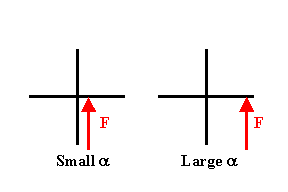 Assume you want to enter a building
with a rotating door. The door has four panels, and you push
on one of them, perpendicular to the surface of the panel.
Assume you want to enter a building
with a rotating door. The door has four panels, and you push
on one of them, perpendicular to the surface of the panel.
The rate, at which the angular velocity of the door
changes, i.e. the angular acceleration α,
is greater the farther away from the axis of rotation you apply the
force.
Angular acceleration about a point is the result of a torque about this point. A
torque
is the product of a lever
arm and a force that is applied perpendicular to the lever arm. The
lever arm or
moment arm
is the perpendicular distance from the center of rotation, i.e. from the
pivot point, to the point where the force is applied.
A torque is always defined with respect to a pivot point.
A larger torque produces a larger angular acceleration. You can
get a larger torque by applying a larger force, or by using a longer
lever arm. We write
torque = lever arm × force,
τ = r × F.
 Torque is a vector. It is
the vector product or
cross product of r and F. The SI units of torque are Nm.
Torque is a vector. It is
the vector product or
cross product of r and F. The SI units of torque are Nm.
Torque has magnitude and direction. Its direction is given by the
right-hand rule.
Let the fingers of your right hand point from the axis of
rotation to the point where the force is applied. Curl them into
the direction of F. Your thumb points in the direction of the
torque vector.
The magnitude of the torque τ
is τ =
rFsinθ, where θ is the smallest
angle between the directions of the vectors r
and F.
We can also write τ
= rperpF =
rFperp, where rperp is the component of
the lever arm perpendicular to F, or where Fperp is the
component of F perpendicular to the lever arm.
If a force
F acts on an object, then the torque produced by this force about a
pivot point is τ = r × F,
where r is the displacement vector from the pivot point to the point where the
force is applied. If two or more forces act on an object, then the net torque is the
vector sum of
the torques produced by the separate forces. (For rotations about a single axis,
two torques can point in the same direction or in opposite
directions and therefore can add or subtract.)
Summary
Rotations is the most difficult subject of the course for most students.
The vector nature of the quantities describing rotation is counterintuitive
initially, but the math behind rotations is the vector cross product.
Rotation are defined about an axis. To start an object rotating about
an axis, i.e. to give it angular acceleration, you need a force. But not any old
force will do. It depends on where you push or pull, and in which
direction.

Assume you want to start the wheel spinning. Let the red arrows
indicate the direction of the force you apply. Which arrow will accomplish
this? You cannot push directly on the axis, that will not work. You
need a lever arm. You also cannot push towards the axis, even if you have
a lever arm. The force has to have a tangential component. All this
is incorporated in the concept of the torque.
torque = lever arm × force,
τ = r × F.
Here r is the lever arm, pointing from the axis of rotation to the
point where the force is applied, F is the force. The cross product says that they cannot
be aligned because the magnitude of the torque is τ = rFsinθ, where θ is the
smallest angle between the directions of the vectors r and F.
The cross product is the mathematical way of expressing what is needed to
achieve angular acceleration.
Problem:
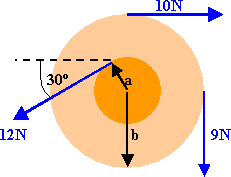
 In the figure on the right, find the net
torque on the wheel about the axle through the center if a = 10 cm and b
= 25 cm.
In the figure on the right, find the net
torque on the wheel about the axle through the center if a = 10 cm and b
= 25 cm.
Solution:
- Reasoning:
Let the z-axis come out of the page. Use τ = rFsinθ for the magnitude
and the right-hand rule for the direction of
τ.
- Details of the calculation:
The torque produced by the 10 N force then is
τ = -(10 N
* 0.25 m) k = -(2.5 Nm) k.
The torque produced by the 9 N force is
τ = -(9 N
* 0.25 m) k = -(2.25 Nm) k.
The torque produced by the 12 N force is
τ = (12 N
* 0.1 m) k = (1.2 Nm) k.
(Note that this force is also applied
perpendicular to the lever arm.)
The total torque is
τ = -(3.55 Nm) k.
Newton's second law, when
applied to rotational motion states that the torque equals the
product of the rotational mass or
moment of inertia I and the
angular acceleration α.
torque = moment of inertia × angular acceleration
τ = Iα
The moment of inertia is a measure of an object's rotational inertia. It depends on the
mass of the object and on how this mass is distributed with respect to the axis of
rotation. The farther the bulk of the mass is from the axis of rotation, the greater is
the rotational inertia (moment of inertia)
of the object. The moment of inertia depends on the mass, and how it is
distributed. it does not depend on how much force or torque you apply. If
you apply more torque to a rigid object, you get greater angular acceleration,
but the moment of inertia does not change.
The moment of inertia of a system about an axis of
rotation can be found by multiplying the mass mi of each
particle in the system by the square of its perpendicular distance ri
from the axis of rotation, and summing up all these products,
I = ∑miri2.
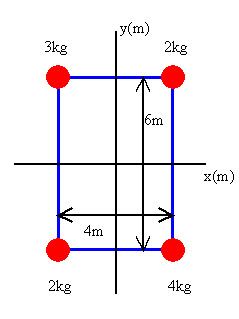 Problem:
Problem:
The four particles in the figure on the right are connected by rigid rods.
The origin is at the center of the rectangle. Calculate the moment of inertia of the system about the z-axis.
Solution:
- Reasoning:
The moment of inertia is I = ∑miri2.
Here ri is the perpendicular distance of particle i from
the z-axis.
- Details of the calculation:
Each particle is a distance
r = (9 + 4)½ m = (13)½ m from the
axis of rotation.
I = (3 kg + 2 kg + 4 kg + 2 kg)*13 m2 = 143 kg m2.
The moment of inertia of an object is a measure of its resistance to angular acceleration.
Because of its rotational inertia you need a torque to change the angular velocity of an
object. If there is no net torque acting on an object, its angular velocity will not change.
If it is initially not spinning, it will not start spinning. If it is spinning with a given
angular velocity, this angular velocity will not change. Both, its angular speed and the
orientation of its axis of rotation, will stay the same.
constant angular velocity <--> no angular
acceleration <--> no net torque
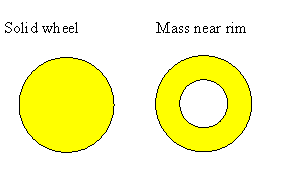 When two objects are acted on by the same torque, the
object with the larger moment of inertia has the smaller angular
acceleration. The units of the moment of inertia are
units of mass times distance squared, for example kgm2.
When two objects are acted on by the same torque, the
object with the larger moment of inertia has the smaller angular
acceleration. The units of the moment of inertia are
units of mass times distance squared, for example kgm2.
Imagine two wheels with the same mass. One is a solid wheel with its
mass evenly distributed throughout the structure, while the other has
most of the mass concentrated near the rim.
The wheel with the mass near the rim has the greater moment of
inertia.
The moment of inertia is
defined with respect to an axis of rotation.
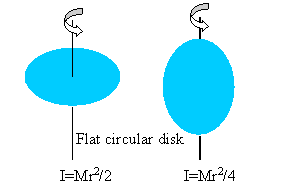 For example, the moment of inertia of a circular disk spinning about an axis
through its center perpendicular to the plane of the disk differs from
the moment of inertia of a disk spinning about an axis through its
center in the plane of the disk.
For example, the moment of inertia of a circular disk spinning about an axis
through its center perpendicular to the plane of the disk differs from
the moment of inertia of a disk spinning about an axis through its
center in the plane of the disk.
External link: List
of moments of inertia
The seesaw
Two children are playing on a seesaw, rocking back and forth. The center of
the seesaw is fixed. There is no translational motion. We observe rotational
motion about the center. While the seesaw is moving there is practically no
torque on the seesaw, and it rotates with uniform angular velocity. The weight
of each child times the lever arm from the center to where the child is seated
produces a torque, but the two torques have the same magnitude and point in
opposite directions and therefore cancel. If one child is heavier, it sits
closer to the center than the lighter child. This reduces the lever arm. In
this way, different weights can produce torques of the same magnitude.
When one child's feet hit the floor, the floor pushes back and produces a
torque pointing opposite to the angular velocity. This torque will reduce the
angular velocity to zero in a short time interval. The seesaw is now stopped.
The child then pushes off and the ground pushes back. The direction of the
torque stays the same. The torque produces an angular acceleration which results
in an angular velocity pointing opposite to the original direction. The seesaw
reaches its final angular velocity when the child stops pushing. It now keeps
on rotating with constant angular velocity, until the other child's feet hit the
floor.
 When a wheel rotates about the z-axis, each point on the wheel has the same angular
speed. The linear speed v of a point P, however, depends on its distance
from the axis of rotation.
When a wheel rotates about the z-axis, each point on the wheel has the same angular
speed. The linear speed v of a point P, however, depends on its distance
from the axis of rotation.  Assume you want to change a rotating
wheel's angular speed. To increase the angular speed you
probably will apply a force to the rim, tangential to the rim, and in
the direction of the instantaneous velocity of the section of the rim to
which you apply the force.
Assume you want to change a rotating
wheel's angular speed. To increase the angular speed you
probably will apply a force to the rim, tangential to the rim, and in
the direction of the instantaneous velocity of the section of the rim to
which you apply the force.
 Assume you want to enter a building
with a rotating door. The door has four panels, and you push
on one of them, perpendicular to the surface of the panel.
Assume you want to enter a building
with a rotating door. The door has four panels, and you push
on one of them, perpendicular to the surface of the panel.
 Torque is a vector. It is
the
Torque is a vector. It is
the 

 In the figure on the right, find the net
torque on the wheel about the axle through the center if a = 10 cm and b
= 25 cm.
In the figure on the right, find the net
torque on the wheel about the axle through the center if a = 10 cm and b
= 25 cm. Problem:
Problem:  When two objects are acted on by the same torque, the
object with the larger moment of inertia has the smaller angular
acceleration. The units of the moment of inertia are
units of mass times distance squared, for example kgm2.
When two objects are acted on by the same torque, the
object with the larger moment of inertia has the smaller angular
acceleration. The units of the moment of inertia are
units of mass times distance squared, for example kgm2. For example, the moment of inertia of a circular disk spinning about an axis
through its center perpendicular to the plane of the disk differs from
the moment of inertia of a disk spinning about an axis through its
center in the plane of the disk.
For example, the moment of inertia of a circular disk spinning about an axis
through its center perpendicular to the plane of the disk differs from
the moment of inertia of a disk spinning about an axis through its
center in the plane of the disk.